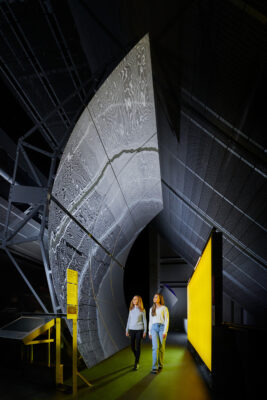Energy Revolution: The Adani Green Energy Gallery explores how the world can generate and use energy more sustainably to urgently reduce carbon dioxide emissions from global energy systems and limit the impact of climate change. This free gallery examines this century’s defining challenge across three sections:
In Future Planet, visitors can examine how climate scientists use mathematics and complex computer-based models to understand our planet, and what these tell us about the range of climate futures that might lie ahead.
In Future Energy, technologies – and the people behind them – that are reimagining how energy is supplied and used today are highlighted alongside historic artefacts which provide a longer view of the energy transition away from fossil fuels.
Our Future looks forward to a new world that is being dreamt up, with children’s creative ideas of how the world will meet its future energy needs displayed with expert responses to them.
The gallery showcases striking contemporary objects, and stories of individuals, organisations and communities from the UK and abroad, all imagining the future of low carbon energy, and spotlights some of the earliest ideas and technologies created by the imaginations of previous generations.
Visitors begin their journey learning about climate modelling and can see projections of how Earth’s systems may possibly change in the future. They can watch a film exploring how computer models can improve understanding of climate impacts in the Global South and browse a mass display of instruments from the collection used to measure the climate from space as well as on land, air and at sea.
Vital low-carbon technologies for the energy transition are on display, from nuclear, hydrogen and solar to wind and tidal power. For the first time visitors can see a quadrant from the Zero Energy Thermonuclear Assembly (ZETA), a nuclear fusion experiment created in the late 1950s, alongside models of a modern small modular nuclear reactor, which may power more of our homes in the future, plus part of a real (but non-radioactive) canister used for storing nuclear waste in the UK.

Other objects on display showcase the sheer variety possible with solar power, from a model of a solar-powered classroom which supports schoolchildren and local communities in India and Uganda, to the towering 5m tall parabolic solar trough mirrors used on huge solar farms to concentrate sunlight and generate electricity. Visitors can also try their hand at an interactive game to solve challenges at solar installations across the world.

The Scottish islands of Orkney play an important role in the energy transition, with abundant wind and tidal energy being harnessed to develop an innovative hydrogen economy. Visitors can see a model of the renewable energy projects on the islands and watch a film featuring the people and places behind these pioneering projects. On display in this section for the first time is a vast 7m long tidal turbine blade that once helped to generate enough electricity to power a thousand homes.

Electrification has a long history, and it was by imagining a world powered by electricity, that American inventor Thomas Edison created the world’s first public electricity network in London in 1882 and established how electricity is supplied to this day. On display for the first time are rare surviving Edison tube mains cables which made this feat of engineering possible and transformed the way we live. Visitors can also marvel at the first electric taxi hailed by Londoners in 1897. These remarkable innovations remind us that major change is possible and that many of the technologies needed to achieve the energy transition already exist.

The challenges of electrification, energy storage, and supply and demand are also explored in the galley, with visitors invited to play interactive games and use models that show how energy can be generated and distributed. Possible routes to low-carbon transport are featured, as well the decarbonisation of our buildings and construction industries.
In the final section, visitors are encouraged to imagine the future and use their creativity as a powerful tool for generating knowledge, stimulating innovation, and shaping decisions about how we live. This section features a digital installation showing children’s ideas and scientific experts’ responses to them. It also displays a decarbonisation tracker so that visitors can see how the UK is performing on its low carbon journey.
At the centre of the gallery, uniting science and art, is Only Breath, a sculpture that breathes and blooms, stretching to around 5 metres wide when unfurled, and signifies the power of nature to inspire technological change.

The gallery is situated on Level 2 in the museum’s West Hall, and was designed by award-winning architects, Unknown Works. A key element of the gallery’s sustainable design was the reuse of redundant shelves from the Science Museum’s former object store to create sustainable plinths. The gallery’s carbon footprint has been monitored and recyclable aluminium was also used where possible.
The gallery’s Title Funder is Adani Green Energy, a major Indian renewables company.
Book your free admission ticket to the museum to see Energy Revolution: The Adani Green Energy Gallery.
